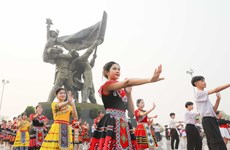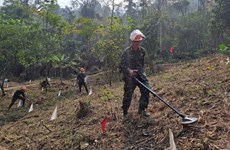Archaeological institute celebrates successes
The Institute of Archaeology under the Vietnam Academy of Science and
Technology has contributed remarkably to the research of national
history, sovereignty and traditional cultural values.
The Institute of Archaeology under the Vietnam Academy of Science and
Technology has contributed remarkably to the research of national
history, sovereignty and traditional cultural values.
Most worthy of note is the institute’s trace of Vietnamese people’s ancestry, said the institute’s Director Tong Trung Tin at a ceremony to mark its 45 th founding anniversary in Hanoi on November 29.
According to Tin, the institute has proven the existence of Hung Kings, who had been believed as legendry founders of Vietnam , thus helping to shed light on an unknown period of time in the country’s history.
Together with the country’s archeological sector in general, the institute has outlined a vivid picture of Vietnam in its early days of national construction and protection, he added.
Acknowledging the important role archaeology plays in studying national history and protecting the country’s sovereignty, the institute has conducted research in Truong Sa (Spratly) archipelago, the Central Highlands and the southern region.
In Truong Sa, they discovered traces of the continuous presence of Vietnamese people between the 10th century and the 20 th century, contributing to proving the country’s sovereignty over the archipelago at an early date.
The institute has also contributed to preserving national heritage through discovery, research and assessment of historical relics, Tin noted, adding that it has compiled over 670 dossiers that provide important data for the preservation and upgrading of heritage.
Thanks to those efforts, many Vietnamese heritage sites have been recognised by UNESCO, including the Thang Long royal citadel and the Ho citadel.
Tin pointed to challenges and difficulties faced by the institute, such as poor research facilities and heritage sites on the brink of vanishing.
The institute plans to prioritise coordination with localities to conduct fundamental research and underwater archaeological activities in service of the national strategy on research and exploitation of the marine resources, he said.-VNA
Most worthy of note is the institute’s trace of Vietnamese people’s ancestry, said the institute’s Director Tong Trung Tin at a ceremony to mark its 45 th founding anniversary in Hanoi on November 29.
According to Tin, the institute has proven the existence of Hung Kings, who had been believed as legendry founders of Vietnam , thus helping to shed light on an unknown period of time in the country’s history.
Together with the country’s archeological sector in general, the institute has outlined a vivid picture of Vietnam in its early days of national construction and protection, he added.
Acknowledging the important role archaeology plays in studying national history and protecting the country’s sovereignty, the institute has conducted research in Truong Sa (Spratly) archipelago, the Central Highlands and the southern region.
In Truong Sa, they discovered traces of the continuous presence of Vietnamese people between the 10th century and the 20 th century, contributing to proving the country’s sovereignty over the archipelago at an early date.
The institute has also contributed to preserving national heritage through discovery, research and assessment of historical relics, Tin noted, adding that it has compiled over 670 dossiers that provide important data for the preservation and upgrading of heritage.
Thanks to those efforts, many Vietnamese heritage sites have been recognised by UNESCO, including the Thang Long royal citadel and the Ho citadel.
Tin pointed to challenges and difficulties faced by the institute, such as poor research facilities and heritage sites on the brink of vanishing.
The institute plans to prioritise coordination with localities to conduct fundamental research and underwater archaeological activities in service of the national strategy on research and exploitation of the marine resources, he said.-VNA












